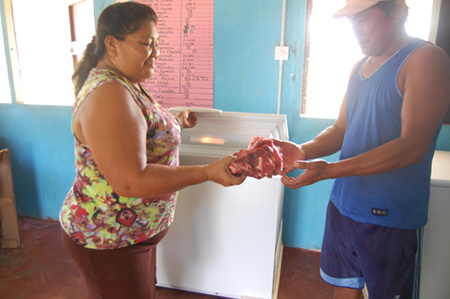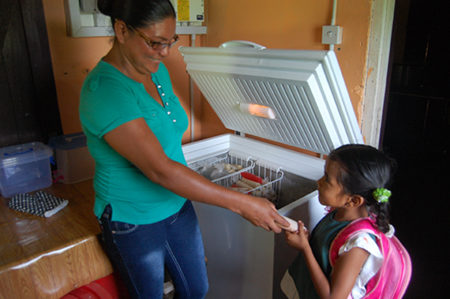Georgetown-June 2017: The Guyana Energy Agency (GEA) is currently providing technical support to the Latin American Energy Organization (OLADE) Energy Project which seeks to implement pilot/demonstration sustainable energy initiatives in three rural communities in Guyana.
Funded by the Canadian Government, the project, titled ‘Corporate Social Responsibility Renewable Energy Project’, seeks to enhance and accelerate productivity in the rural communities of Shulinab (Region 9), Powaikoru (Region 1) and Moraikobai (Region 5), through the use of renewable energy technology.
The pilot projects were defined based on the communities’ requirements (Demand-driven) with focus on generating new income as a condition for sustainability. This was facilitated by a team of Engineers from GEA along with an OLADE consultant who visited each of the communities to assess what possible projects exist within each village that were sustainable in nature and would further be enhanced through the use of renewable technology. The information gathered from the assessment, which included discussions with the Toshaos and representatives from different village groups, was used to tailor the projects to the needs of each community.
To this end, Shulinab (also known as ‘Macushi Village’), an Amerindian community in South Central Rupununi, Region 9, located on the main South Savannah road about 35 miles south of Lethem and about 12 miles southeast of Parikwarinawa village, received 4 solar PV systems totaling 1960 Watts Peak, 6 solar powered freezers, two energy efficient wood stoves and two solar dryers under the project.
With a population of 775 persons, Shulinab’s primary economic activities are fishing, tourism, livestock, fruit processing and craft. Based on the assessment conducted it was realized that there was need for refrigerators to store meat, processed fruits and perishable items for the ‘hot meals’ programme that benefitted about 36 students on a daily basis. Given that one of the village’s main economic activity is fruit processing, the need for energy efficient dryers and stoves was also recommended.
Having recently completed the last of the installations, GEA visited Shulinab and learnt that the project has significantly benefitted the village. Ms. Joan Stevens who is in charge of the ‘Hot Meals’ programme and snackette indicated that they are extremely grateful for the solar PV system that her group received and the solar powered freezer. “Since we received it we have been able to add items to the list of things we sell. We now offer icicles, custard, cool down and ice,” she said. Ms. Stevens further enthused that they were also able to “… offer meat balls and patties as we now have somewhere to store the meat”.
Given that one of the objectives of the project was the generation of new income GEA’s officers were interested in finding out whether this objective was achieved. To this end, Ms. Stevens eagerly displayed her accounting ledger and explained that “…because of the additional items we now offer we have been able double our profits”. “Prior to receiving the PV system and freezer we use to make 20-25 thousand dollars in profit per month now we make 45-50 thousand per month”, she said proudly. Further, in order to generate even more income, they have recently used some of the profit they made to “….add a stationary section to the canteen”.
The additional profit, also allowed for them to employ 3 women and they are seeking to employ a fourth “someone skilled in pastry making as we want to further broaden the list of items we are offering in the snackette to generate even more income.” She said that the icicle, cool down and custard are a hit with the children and even some adults, so each day’s supply was usually sold out “…which means that at the end of each day we have to make a fresh set.”
Stepping over to the village office, which also serves as the meat centre, Mr. Calvan Josey who operates the centre, had a similar account as that of Ms. Stevens. He indicated that the village Council had 200 heads of cattle while the village had about 600. Expressing how much the village has benefitted from the PV system and freezer that the office received he explained that “…before we use to slaughter once a month…so villagers only got fresh meat once a month”. He further explained that whatever meat was left back they would have to pickle or salt…“Because of the freezer villagers can get fresh meat to purchase all the time as we can now store the meat in the freezer”. According to Mr. Josey, since the installation of the PV system and freezer they recorded sales totaling “one million and forty-three thousand dollars”.

Energy Engineer Brian Constantine, GEA’s representative on the project, explained that part of the sustainability component of the project includes each group being required to pay a subscription fee of fifteen thousand dollars per month to the Village Council. “This fee will be used to sustain the equipment that village has received. Therefore, should any repairs be needed for either the PV systems or Refrigerators the Council will have money to facilitate those repairs”, he explained. When asked Ms. Stevens, who also assists with the villages’ accounts, indicated that each group has been paying their rental fees as agreed. These payments totaled over $160,000 for the period January to May 2017.
The women’s group who received two solar freezers, a solar PV system, two energy efficient cook stoves and two solar dryers indicated that though they have used the freezers for storage of ice, icicle and beverage, in October when the fruits that they process are in season, they will commence full use of the items they have received.
It is hoped that the projects would serve as an enhancement of corporate social responsibility (CSR) by fostering interest and support from Guyana’s private sector in replicating, advancing and/or expanding the project (s) based on the outcomes and experiences.

Both Ms. Stevens and Mr. Calvan expressed thanks to OLADE, the Canadian Government and GEA on behalf of the Toshao Mr. Nicholas Fredericks who was away on business at the time of GEA’s visit. The project will continue to be monitored by representatives of all the stakeholders involved to ensure that there is continued compliance with the objectives.

